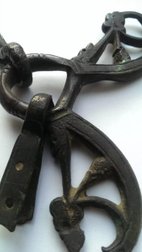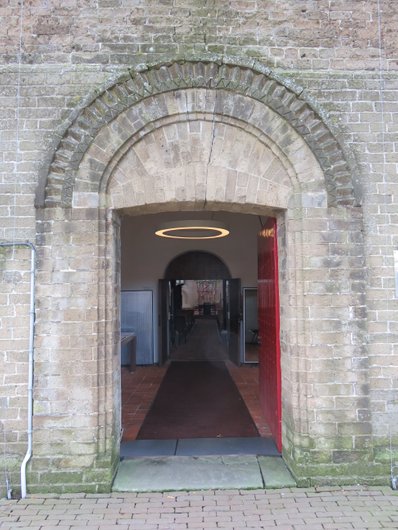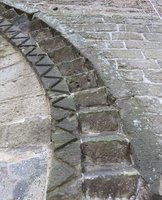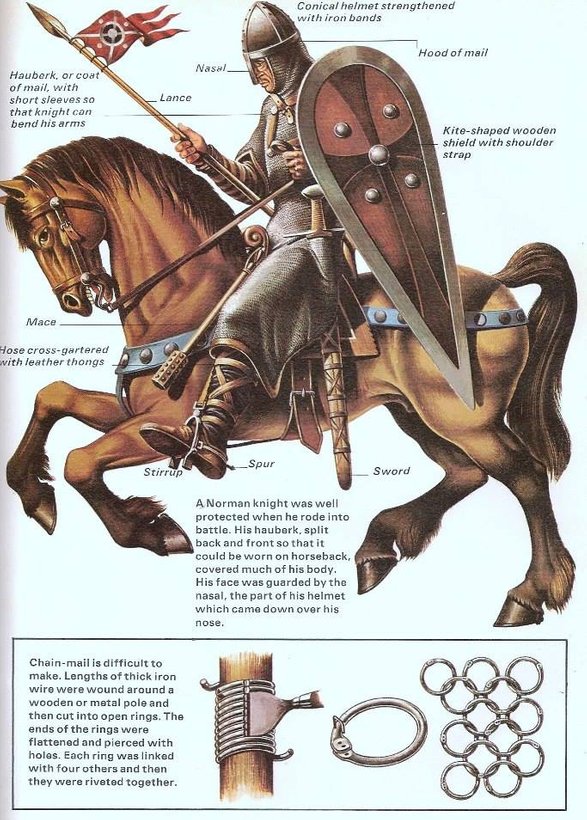Late viking or Anglo-Norman horse bridle cheek pieces.
These two parts of a horse bridle cheek pieces as part from the adornment accompanying the bit in the slideshows are interesting. Stylistically, they belong to the very latest part of the Viking Age, though distinct elements direct them to be of Anglo-Norman origin, late 11th or first part of the 12th century. The more 'softened' curvy, floral depiction of the dragon and claw depicted in the roundel, alongside the almond shape eye are characteristics of the (very) Late Viking Age and Anglo-Norman period. One might say we can distinct here a transverse late Urnes-romanesque style here. Both part having some roots of this late Viking art style, yet, stepping into the romanesque art style, the Normans brought with them from the continent and the Anglo-Normans further developing it in the following century.
Once integral part of the bridle mount on both sides of the bit, they broke off, due to being delicate objects to the bridle and firm use, riding the horse. A cheek-piece on the outside of a bit (not to be confused with the leather or fibre strapping wich connects to the bit) fulfills the task of stopping a mouthpiece slipping in the horse's mouth, making the bit ineffective as a means of control. As such, it needs to have certain features, such as a suitable aperture to feed the connecting strapping through to construct the actual bridle, and some evidence that it was large enough to integrate with the mouthpiece.
The left horse bridle cheeck piece part is 55mm long, 5.5 mm at its thickest point and weighs 39.93 grams.
The horse bridele cheek piece part on the right 60 mm long, 5 mm at its thickest point and weighs 34.14 grams.
Horse bridle pieces are rare finds, let alone complete examples, as the example shown in the middle from Hunt museum, Limerick and the - unprovenanced - example shown in the slide shows as to illustrate how the part would have been attached originally. The two parts shown here, were found in the late eighties on the shores of Strangford Lough, Ireland. Between the 9th & 11th-centuries, Vikings were regular visitors to the lough, giving it the Norse name 'Strangfyorthe', meaning the place of strong currents or strong fjord. They were no doubt attracted to the area by the promise of rich plunder at the various monastic sites. However, they were not always a warring people, and there is evidence to suggest that many traded peacefully and even settled locally. In 1177, John de Courcy and his Norman Knights invaded Downpatrick. The surrounding region was brought under Norman control by building a number of fortified mottes and founded the Cistercian monasteries of Inch Abbey (1180AD) and Grey Abbey (1193AD).
Image above: Audley's Castle, overlooking Strangford Lough.
When we take a closer look to the two horse cheeck pieces, we see some features who distinctively to an Anglo-Norman origin. On the left example, we see a zig-zag, chevron ornament, wich can be found on several type of items and Surfaces in Europe from the late 11th throughout the 12th century as being part of a romanesque stylistic element, wich the Normans brought with them when they invaded England and, later, Ireland. This chevron ornament can also be recognised in the - very basis - depiction of this motif on a church in Vries, in the provence of Drenthe in The Netherlands. From the same provence is are two remarkable stirrup, found in Zwinderen, and dated app. 975 - 1100 AD. One of them has chevron ornament and some faces looking at us (as also known on ornamental work on romanesque churches). See images hereunder.
References: (links attached)
Hill, I. 2007. Strangford : Portrait of an Irish lough
McErlean, T. 2002. Strangford Lough: An Archaeological Survey of the Maritime Cultural Landscape
Moss, R. 2009. Romanesque Chevron Ornament - The language of British, Norman and Irish sculpture in the twelfth century,
Pedersen, A. 1996-1997. Riding gear from late Viking Denmark - Journal of Danish Archaeology 13. 133-161
Wilde, W.R., 1861. A descriptive catalogue of the antiquities of animal materials and bronze in the museum of the Royal Irish Academy. Dublin: Hodges
The church of Vries, provence of Drenthe, The Netherlands - see also blog
The Drents museum in Assen, provence of Drenthe, The Netherlands.
See also the image on the horse harness equipment
<script>
(function(i,s,o,g,r,a,m){i['GoogleAnalyticsObject']=r;i[r]=i[r]||function(){
(i[r].q=i[r].q||[]).push(arguments)},i[r].l=1*new Date();a=s.createElement(o),
m=s.getElementsByTagName(o)[0];a.async=1;a.src=g;m.parentNode.insertBefore(a,m)
})(window,document,'script','//www.google-analytics.com/analytics.js','ga');
ga('create', 'UA-56164482-1', 'auto');
ga('send', 'pageview');
</script>
Well. I could have been with these stones until after dark, but as my wife wanted to travel on.. well.. I see you again, some day, hogback stones from Gosforth. And if you happen to be there one day, do not forget that monument on the outside...
Further on with the Cumbrian hogbacktour !
In - yes, luckily again in - St. Peter's church in Heysham, there is a truly beautiful hogback stone. The guide told us, it had been studyied by Thor Ewing, a writer, in 2000. in 'Understanding the Heysham hogback' A tenth century sculpted stone monument and its context (link), Thor Ewing tells in detail what he dicovered on the both sides of this hogback stone.
Just being brought in the church as late as the 1970's accompanied with some protest here and there among the church visitors, considered as being a token of old paganism, it had been remarkably nice preserved, and a lot of detail can be seen, still. Truly worthwile a visit.
I had a small debate with the guide in the church if the - zoomorphic, in my opinion - faces on the sides were lions (or hippo's). The guide doubted if the vikings could have known about lions. Well I guess so, concerning the runes on the Ancient Greek lion statue at the Arsenal, Venice. For example. Vikings did travel south..
But when he told me he was doubting the vikings 'discovered' (as the native inhabitants were of course, in the first place) America before Columbus, I decided to rest my case..
One has to know when to start and to end a conversation ..
Just discovered the book in a bookstore written by Geoff Holder - The guide to the mysterious Lake District, I knew there had to be another hogback stone in Lowther, St. Micheal's Church. With a promising image described in the text of 'a naval and a land-based force of shield-bearing vikings above a fish and what might be a coiled sea serpent. On the reverse is a row of female figures with snakes, possibly a representation of the hideous hag Hel'. Wow. If that did not sound as a true pagan promised land ..
Not complaing too much after all we have seen, this visit was the dissapointing one of them all. But if you wife states 'I am happy to have seen them' and I am answering 'Measuring is knowing' and the even more obligate verb 'handling 'if we did not see it at all, we wouldn't have known anything at all of how they were looking' the glass was again half full, at the last day of our journey..
The hogback stone appeared to be just being tolerated within the entrance segment part of the church. As something you never use anymore but you do not throw away - entirely. That sort of feeling emerged when seeing this hogback asylum seekers.. Bed, bath and bread, ás we say in Dutch, but no luxury at all and standing on some outcuts of wood, you would balance the table with at home..
Come on, St. Micheal's Church.. care a bit more of your 'children' !
This hogback stone was moved in the church in 1907. Hogback stones layed partially buried in the churchyard before it was dug up and moved into the church.
The promising depiction of a longship - as certainly can be seen after some studying - see http://vikingminds.co.uk/pages/longship
we have missed !
The stone itself is (157 x 50 x 30 cm) and very worn.
The hogback stones in Cumbria - very diverse in quality, but everyone worth a visit ! Especially on a gloomy day in late October ...
The churches to visit - see photos of resp. St. Andrew's church in Penrith, St. Mary's church in Gosforth, St. Peter's church in Heysham and St. Micheal's church in Lowther.
Did I miss out on another one in Cumbria ? Let me know !
In a next blog I will take you to four - still remaining utterly mysterious- statues 'guarding' the graveyard of St. Andrew's church in Dacre..
For the last blog of October 9th see this link.
References: (as always, links to where the books can be ordered are attached).
Edwards, B.J.N. Vikings in North West England - The artifacts (1998);
Emery, Gordon, CURIOUS CUMBRIA, The Lake District & Beyond: A celebration of Cumbria (2023)
Ewing, T. 'Understanding the Heysham hogback' A tenth century sculpted stone monument and its context ;
Hall, R. Viking Age archaeology in Britain and Ireland (first printed 1990, reprinted with amendments in 1995);
Holder, G. The guide to the mysterious Lake District (2009)
possibly also (as there within the part of Cumbria dealing with Carlisle, the Eden Valley, Barrow-in-Furness, Whitehaven and the west coast is being dealed with)
Holder, G. Paranormal Cumbria (2010)
http://vikingminds.co.uk/pages/longship







